Information provided by Therapy Department, George Eliot Hospital NHS Trust "Your potential is our goal."
What is Shin Splints?
Shin splints is the name for pain along the front or inner side of your lower leg, in the area known as the shin. It happens when the muscles, tendons, and bone in the shin become irritated or inflamed, usually because of too much stress or overuse. This condition is common in people who do activities that involve running, jumping, or sudden changes in direction. The pain can start off as a dull ache and might get worse with more activity.
What Causes Shin Splints?
Shin splints are most often caused by activities that put stress on your lower legs, especially if you suddenly increase the amount or intensity of exercise. Some common causes include:
- Your activity involves running or jumping on hard or uneven surfaces.
- A sudden increase in activity, particularly vigorous activities.
- You have recently started running.
- Wearing shoes that don’t fit properly or don’t support your feet well can cause extra stress on your shins.
- Flat feet or high arches: This can lead to extra strain on the shins when walking or running.
Other Possible Causes of Shin Pain:
Shin pain can also come from other problems, such as:
- Stress fractures: Small cracks in the bones of your shin.
- Tendinopathy: Irritation of the tendons around the shin due to overuse/overload.
- Compartment syndrome: Swelling of the muscles in your shin that can press on nerves and blood vessels.
- Muscle strains: Injuries to the muscles in your lower leg.
What are the Symptoms of Shin Splints?
The main symptoms of shin splints are:
- Pain along the inner part of the shin: This may start as a dull ache and can get worse with activity.
- Tenderness: The area may feel sore to touch.
- Swelling: Sometimes there might be mild swelling along the shin.
- Pain that gets worse with exercise: The pain might go away with rest but comes back when you start moving again.
How Common Are Shin Splints?
Shin splints are especially common for people who are active in sports. Runners, dancers, and athletes who jump a lot are most at risk. Shin splints affect both children and adults.
How Long Will Shin Splints Last?
Shin splints can last anywhere from a few days to a few weeks, depending on how bad the pain is and how quickly you treat it. If you keep pushing through the pain, it might take longer to heal. Rest and proper care are key to getting better faster.
What Can I Do to Help Shin Splints?
Here are some steps you can take to help relieve shin splint pain:
- Rest: Give your shins a break from activities that make the pain worse, like running or jumping.
- Ice: Apply ice to your shins for 15-20 minutes every few hours to help reduce swelling and pain. Wrap the ice in a towel to protect your skin.
- Elevate your legs: This helps reduce swelling.
- Stretch: Gentle stretching of the muscles in your calves and shins can help ease the tension.
- Strengthening: Once the pain starts to ease, you can begin doing exercises to strengthen the muscles in your lower legs. Stronger muscles will help prevent shin splints from coming back. Your physiotherapist can give you a plan for safe strengthening exercises.
- Use supportive shoes: Make sure your shoes are comfortable and fit well. Sometimes, custom insoles can help with problems like flat feet or high arches.
When should I get help?
If you have shin pain, you can try to manage it yourself with rest and painkillers before you see a physiotherapist or GP, you should speak to your physiotherapist or GP if:
- The pain is so severe that you have to stop exercising, or pain continues when you are not exercising, at rest.
- The pain doesn’t improve or keeps getting worse, even with rest.
- You feel pain without an obvious cause.
- Your muscles feel very tight, hard, or swollen.
- You notice swelling over your shin bone
Treatment for Shin Splints
Here’s what your physiotherapist or GP might recommend:
- Physiotherapy: Exercises to strengthen or stretch the muscles around your shin and improve your flexibility.
- Take a period of rest from the activity that caused your shin splints in the first place.
- Gradually build up to previous activity levels after a period of rest.
Tips for Preventing Shin Splints
Once you’ve healed, here are some tips to help prevent shin splints from coming back:
- Gradually increase activity: Don’t suddenly jump into intense exercise. Slowly build up your activity level.
- Warm-up and cool-down: Always stretch before and after exercise to keep muscles flexible.
- Wear appropriate footwear: Choose shoes that fit well and provide good support for your activity.
- Cross-train: Mix up different types of exercises to avoid overloading the same muscles, specifically high impact exercises and low impact exercises.
Exercises to help shin splints:
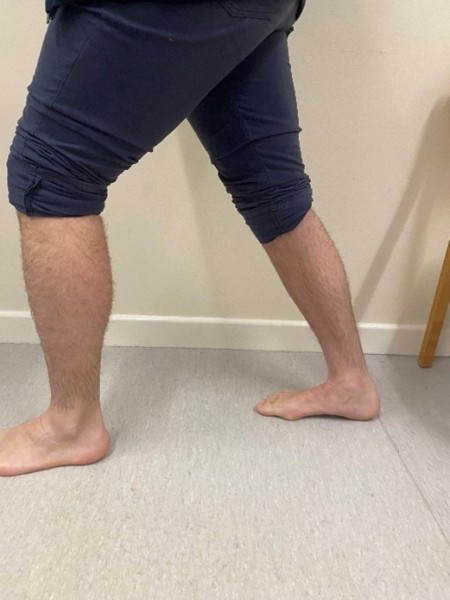
Calf stretch
Step your affected leg back and other leg forward. Keeping your back heel on the floor, lean forward and feel a stretch in the calf muscle. Hold for 15-20 seconds and relax. Repeat 2-3 times.
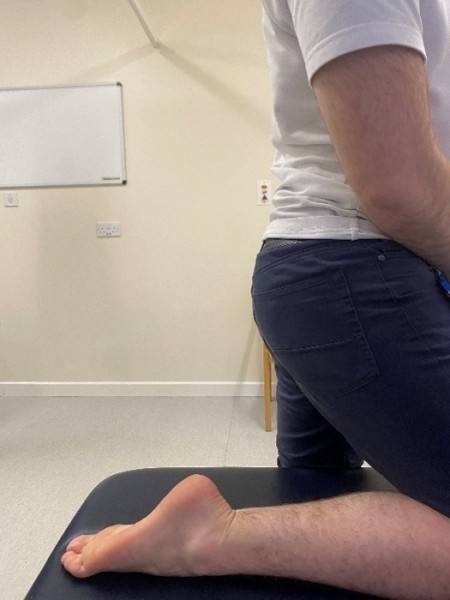
Tibialis anterior stretch
Stand next to a chair or bed, ensuring it's stable.
Place the top of your foot (the one you want to stretch) on the chair or bed with your toes pointing down.
Press your toes downward toward the surface, gently pushing the top of your foot into the chair or bed. This action will stretch the front of your shin.
Hold for 15-20 seconds. Repeat 2-3 times.
Calf Raise
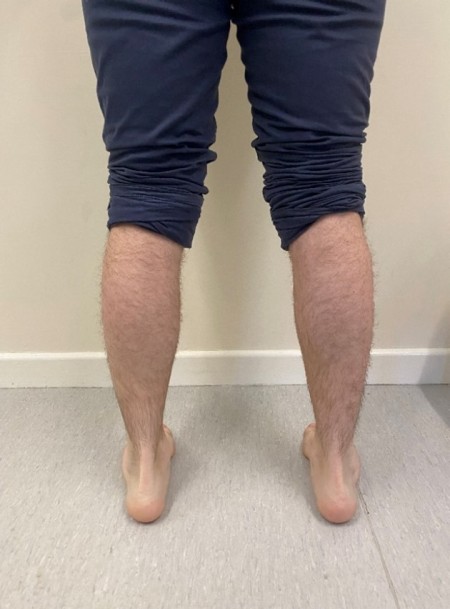
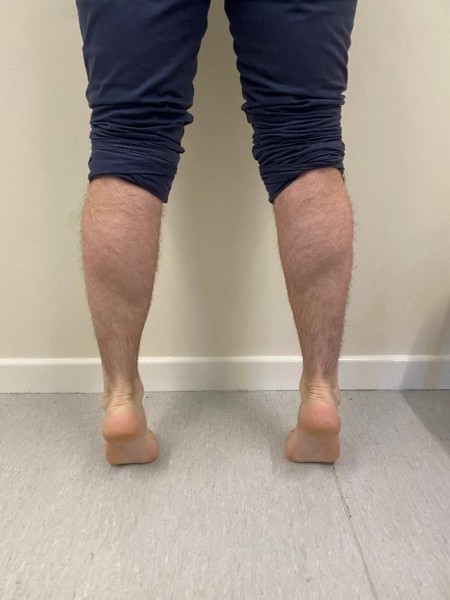
Stand with your feet hip-width apart, keeping your knees straight. Push through the balls of your feet to rise up onto your toes. Pause briefly at the top, squeezing your calves, then slowly lower your heels back down to the starting position. Repeat for 10-15 reps, doing 2-3 sets.
For added intensity, you can perform single-leg calf raises or elevate your feet on a step to increase the range of motion.
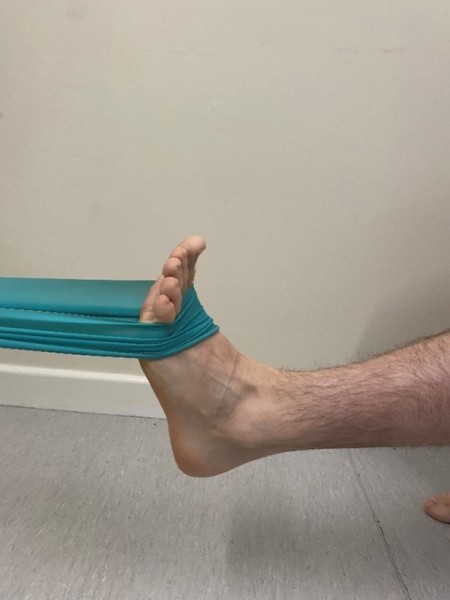
Loop a resistance band around the top of one foot, anchoring the other end to a stable object.
Flex your foot and pull your toes toward your shin, resisting the band's tension. Slowly return to the starting position and repeat for 10-15 reps, 2-3 sets.
George Eliot Hospital is a smoke free environment. For help and advice to stop smoking you can call the national helpline on 0300 123 1044 or visit https://
Copyright
Except where otherwise noted, this item is licensed under the CC BY license (https://
If you are a rights holder and are concerned that you have found material on our patient information resources website, for which you have not given permission, or is not covered by a limitation or exception in national law, please contact us using the Feedback form providing your contact information and full details of the material.